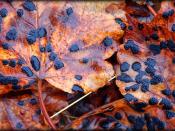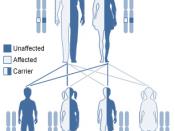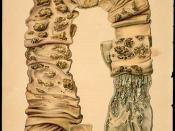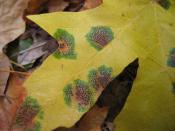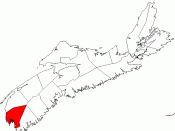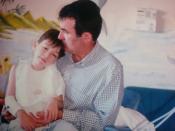Niemann-Pick disease isn't actually one disease at all; it actually is a term used to represent a group of diseases which affect the metabolism. Each member of the group is a direct result of genetic mutations. Of the group, the three most common and most recognized forms of are Types A, B, and C.
Types A and B or Niemann-Pick disease are both causes by the insufficiency of the enzyme acid sphingomyelimase, also known as ASM. Sphingomyelimase is normally found in the lysosome of the cell and is needed to metabolize the lipid sphingomyelin. If this enzyme, ASM, is gone or not working properly, the result is disastrous. The lipid sphingomyelin will not be metabolized and will be accumulated within the cell, eventually causing the death of the cell and, in good time, the malfunction of major organs and organ systems. Even though both types A and B are caused by the same enzymatic failure, the clinical actions are totally different.
Type A Niemann-Pick disease is a severe neurologic disease in which death is usually inflicted by the 2 or 3 year age mark. Most cases of Niemann-Pick are of this sort. Completely opposed to this, the victims of Type B Niemann-Pick disease normally have little or no neurologic involvement and are even susceptible to life late into childhood or even adulthood. The reason that the two different forms of the same disease are so much different is not quite understood in this day of age due to the fact that it is not yet possible to accurately predict the severity of the disease by enzyme testing.
Type C Niemann-Pick disease is very different from its two comrades biochemically speaking. People with this sort of the disease are not able to metabolize cholesterol and other lipids correctly. Because of this, excessively large amounts or cholesterol accrue within the liver and spleen as well as massive amounts of other lipids collecting within the brain. This defect in the metabolization process leads to a secondary reaction which is a reduction is the production of ASM. Because of this action, and the same action occurring in each of the previous two versions of the disease, all forms of the gene were collectively known as "Niemann-Pick Disease." Of course though, this was before the great differences were fathomed about the biochemical aspect of the ailment.
Type D of Niemann-Pick had only been found in one case, in the French-Canadian population of Yarmouth County, Nova Scotia, and is now though to be just another variant of Type C. Genealogical research has uncovered that Joseph Muise and Marie Arruirault, both living circa 1680-1735, are the most likely origin for this type of the disease.
Finally, the next and last version of Niemann-Pick Disease is Type E. This type has not yet been confirmed, but is very highly suspected due to a number of cases that have been stumbled upon in adults who have been found with some of the same tissue and chemical changes as in Type C, but with a very late onset of the symptoms.
Just as the different types of Niemann-Pick vary, so do the symptoms of each. For Type A Niemann-Pick Disease, many symptoms occur, all during the first few months of life. Some of these symptoms are feeding difficulties, an overlarge abdomen within three to six months, progressive loss of early motor skills, a cherry red spot in the eye, and, in most but not all cases, a very rapid decline leading to death by two or three years of age. Type B is very similar to Type A, but the symptoms are just a bit more variable. Abdominal enlargement is a reality, as in the first type, but, since the neurological system isn't damaged for the most part, neurological skills aren't affected, such as loss of motor skills. Along with the symptoms listed, respiratory infections are also present most of the time when dealing with Type B Niemann-Pick Disease.
Type C of Niemann-Pick Disease usually affects kids about the age of just starting school, but the disease isn't limited to this time frame in one's life. Some of the symptoms include jaundice at birth, an enlarged spleen and or an enlarged liver, difficulty with upward and downward eye movements, also knows as Vertical Supranuclear Gaze Palsy, or VSPG, and unsteadiness of gait, clumsiness, or problems with walking, difficulty in posturing the limbs, slurred or irregular speech, learning difficulties and progressive intellectual decline, sudden loss of muscle tone which may lead to falls due to not being able to support one's self, and tremors accompanying movement and, in some cases, even seizures. If a child shows these symptoms before one year of age, they may not even live to be school age. If a child is showing the symptoms after entering school, they may live into their mid to late teens, or maybe even into their twenties. Now, being the astute observer that I am, I've come to the conclusion that if one's child, approximately school age, is acting as a drunken fool would, that is probably a good sign that they are suffering from Type C Neimann-Pick Disease. I have come to this conclusion simply by compiling all of the symptoms of this affliction in my head next to drunkenness and noticing that there are very few differences. I would hate to go off on a tangent, being in the middle of a paper and all, but this makes me hypothesize that perhaps the consumption of alcohol and alcohol accessories actually triggers one's body to go into a state of temporary Type C Niemann-Pick Disease. That is, of course, just a thought, and is not in any way backed up by scientific data.
All symptoms of Niemann-Pick are variable. This means that no single symptom should be used to include or exclude Niemann-Pick as a diagnosis. A person in the early stages of the disease may only exhibit some of the symptoms. Even a person in the latter stages of it may not show all of the indications that could be shown. In addition to this, the symptoms progress steadily during the condition. The rate that the progressions takes place, though, is different from person to person. Alongside this, some of the symptoms of Niemann-Pick are also present in other, more common diseases. Because of these factors and more, it is quite difficult to diagnose a person with this disease.
A person can turn to the National Niemann-Pick Disease Foundation, or NNPDF, for help if they are plagued with the disease. Not only does this foundation help out a person individually if they are fighting the disease, but they can also help that person's family through the rough times. Also, with these two noble actions, they donate money to the research of Niemann-Pick Disease and conduct research of their own to help to find a cure for it.
